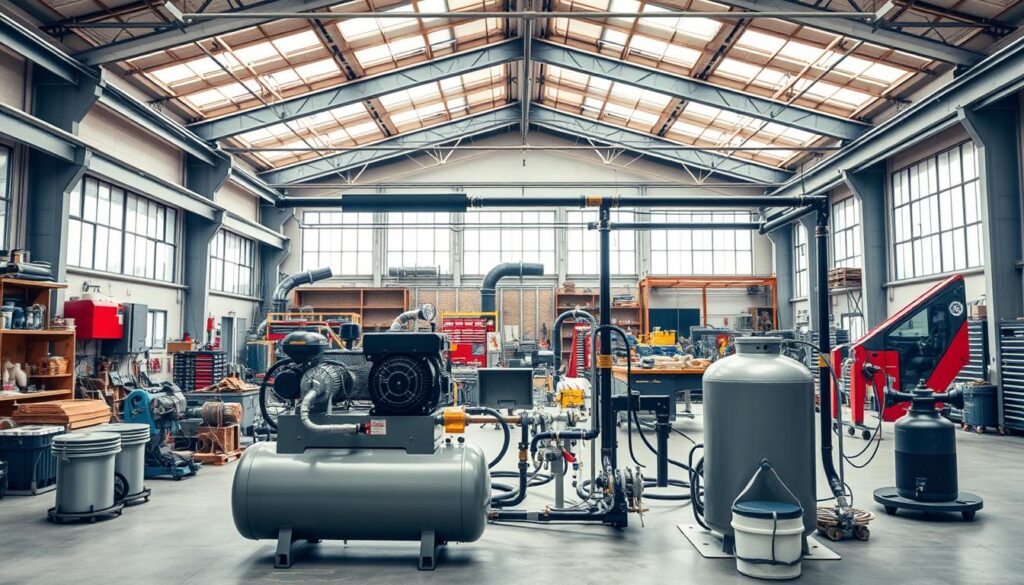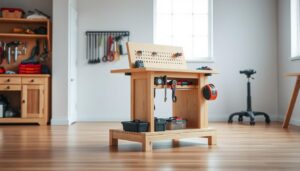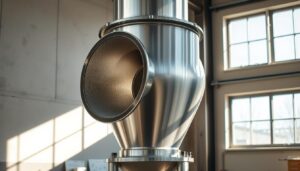When planning a new industrial production site, a well-executed compressed air installation is crucial for ensuring the compressor operates efficiently from the outset.
A properly designed compressed air system not only influences pressure stability and energy consumption but also impacts long-term maintenance needs.
To achieve an efficient and sustainable air supply, it is essential to gather information on general site conditions and consider factors such as operational efficiency, equipment longevity, and safety considerations.
By understanding the key components involved in a compressed air system, including the compressor, filtration, and piping, you can ensure a successful installation process.
Key Takeaways
- Proper planning is crucial for a successful compressed air installation.
- A well-designed air supply system ensures optimal operational efficiency and equipment longevity.
- Compressor selection is critical for the overall performance of the compressed air system.
- Safety considerations must be addressed throughout the installation process.
- A sustainable compressed air system reduces energy consumption and long-term maintenance needs.
Understanding Compressed Air System Requirements
Understanding your compressed air system requirements is crucial for an efficient setup. To achieve this, you need to consider several factors that influence the overall performance and reliability of your system.
Determining Your Air Demand and Pressure Needs
To determine your air demand, you must identify all the tools and equipment that will be using the compressed air system. This involves listing each device along with its required air volume and operating pressure. The total air demand is the sum of the air requirements of all these devices, adjusted by a simultaneity factor to account for the fact that not all devices operate simultaneously.
Operating pressure is another critical factor, as it affects not only the size of the compressor but also its energy consumption. Higher pressure requirements can lead to increased energy costs, so it’s essential to accurately determine the necessary pressure to avoid unnecessary expenses.
| Tool/Equipment | Air Volume Required (CFM) | Operating Pressure (PSI) |
|---|---|---|
| Drill | 10 | 90 |
| Sandblaster | 15 | 100 |
| Air Grinder | 8 | 80 |
Assessing Space and Environmental Conditions
The physical space where the compressed air system will be installed is another vital consideration. Factors such as ventilation, temperature, and accessibility for maintenance play significant roles in the system’s performance and longevity. Ensuring that the installation area is well-ventilated helps prevent overheating, while maintaining a stable temperature above freezing prevents condensation issues.
Environmental conditions like humidity, dust, and temperature fluctuations can significantly impact the system’s performance and component selection. For instance, high humidity may necessitate additional drying capabilities, while dusty environments may require more stringent filtration measures.
By carefully assessing your air demand, pressure needs, space, and environmental conditions, you can design a compressed air system that meets your operational requirements efficiently and effectively.
Planning Your Compressed Air System Setup
To establish an effective compressed air system, you need to consider several key factors. A well-designed system ensures efficient operation, reliability, and cost-effectiveness.
Creating a System Layout
When creating a system layout, consider the location of the compressor unit, piping configuration, and accessibility for maintenance. A well-planned layout minimises pressure drops and energy losses.
Selecting the Right Compressor Type
The type of compressor you choose depends on your specific air demand and application. Options include rotary screw, reciprocating, and centrifugal compressors, each suited to different usage patterns.
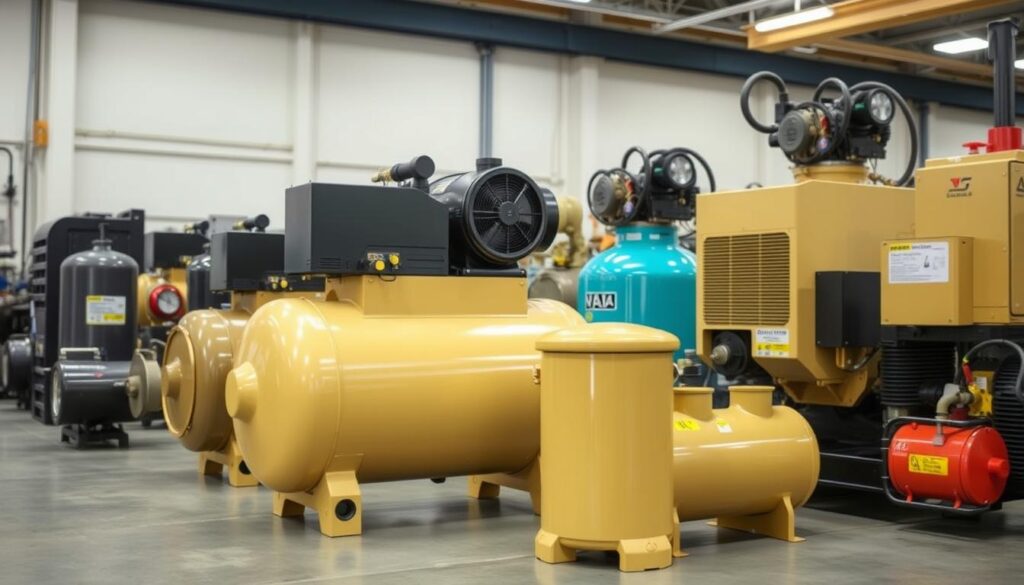
Essential Components to Include
Beyond the compressor, essential components include receivers, dryers, filters, regulators, and lubricators. Proper filtration and air treatment are critical for achieving the required air quality.
Your system should also include a condensate management plan to ensure environmentally responsible disposal.
How to Set Up Compressed Air System: Step-by-Step Installation
The installation of a compressed air system involves several key steps that are crucial for its optimal performance. You need to carefully plan and execute each stage to ensure a safe and efficient operation.
Preparing the Foundation and Location
Before installing the air compressor, you must prepare a foundation that is level, stable, and capable of supporting the equipment’s weight. A concrete pad or a sturdy floor is ideal. Ensure the location provides adequate clearance for ventilation and maintenance access.
- Check the floor’s levelness and stability
- Ensure the foundation can support the compressor’s weight
- Provide adequate clearance around the compressor
Installing the Air Compressor
Position the air compressor in the designated location, ensuring it is securely fastened to prevent movement during operation. Connect the compressor to a suitable power supply, following the manufacturer’s instructions and local electrical codes.
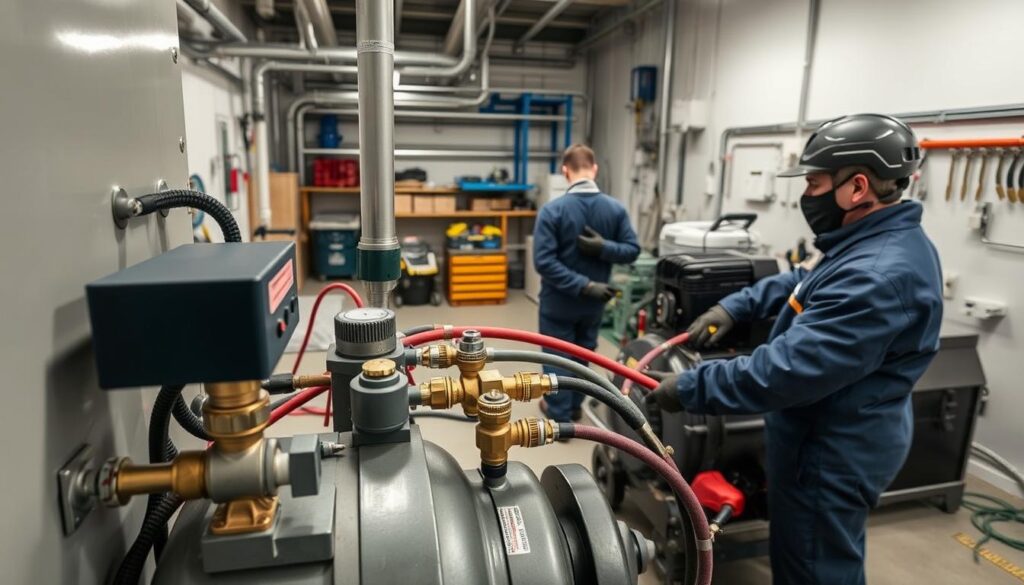
Connecting Power Supply and Safety Features
Connect the air compressor to a suitable power supply, adhering to the manufacturer’s guidelines and local electrical regulations. Install essential safety features, including pressure relief valves and emergency stops, to prevent accidents.
- Connect to a suitable power supply
- Install pressure relief valves
- Implement emergency stops
Setting Up Air Filtration and Treatment Components
Install an air intake filter to prevent contaminants from entering the compressor. Set up air treatment components, such as aftercoolers, dryers, and filters, in the correct sequence to ensure clean and dry compressed air.
- Install an air intake filter
- Set up aftercoolers and dryers
- Install filters in the correct sequence
By following these steps, you can ensure a successful installation of your compressed air system, providing a reliable source of compressed air for your needs.
Testing and Optimising Your Compressed Air System
To guarantee optimal performance, your compressed air system requires comprehensive testing and optimisation. This process involves verifying the system’s integrity, identifying potential leaks, and ensuring it operates efficiently.
Performing Initial Pressure Tests
Performing initial pressure tests is crucial to verify the system’s integrity before full operation. You should gradually increase the pressure to a maximum of 43.5 PSI (3 BAR) to identify possible leaks or anomalies. Increase the pressure steadily, i.e., 14.5 PSI (1 BAR) every 5 seconds until the operating pressure is reached.
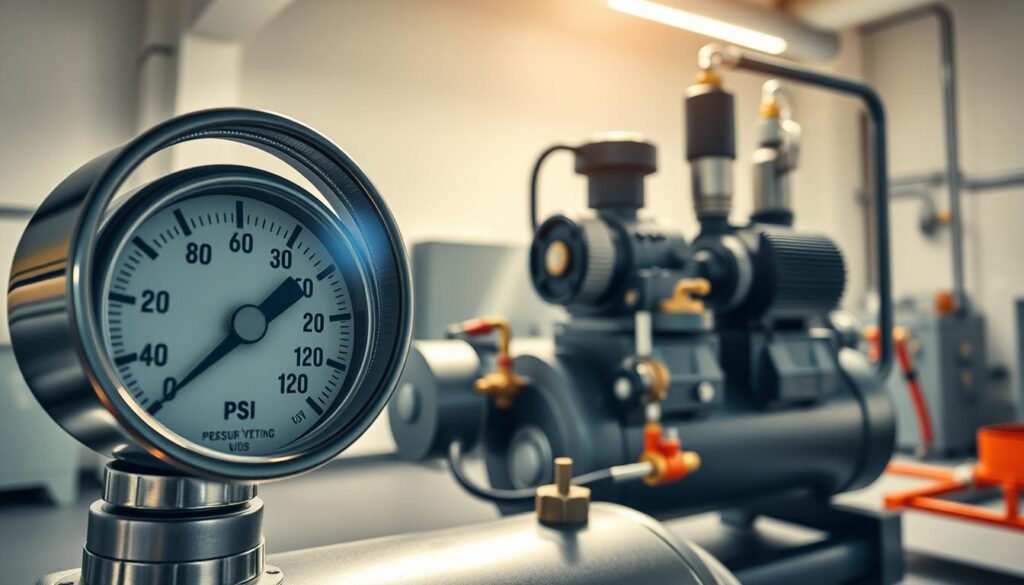
Checking for Leaks and System Efficiency
After the initial pressure test, check connections and listen for audible noises after the first 48 to 72 hours. A comprehensive leak detection process using ultrasonic tools, soap solutions, or pressure drop tests can help identify potential issues. You should also measure and analyze system efficiency, including pressure drops across components and energy consumption.
| Test Type | Purpose | Method |
|---|---|---|
| Pressure Test | Verify system integrity | Gradually increase pressure |
| Leak Detection | Identify potential leaks | Ultrasonic tools or soap solutions |
| Efficiency Analysis | Measure system efficiency | Analyze pressure drops and energy consumption |
Conclusion: Maintaining Your Compressed Air System
The longevity and performance of your compressed air system depend on regular and effective maintenance practices. To ensure optimal operation, it’s crucial to check the status of your system installation annually, paying attention to the condition of tubes for air leaks or damaged parts that may need replacement.
Proper maintenance directly impacts energy consumption, which constitutes the bulk of the total life cycle costs. Creating a maintenance schedule that includes filter replacement, condensate drainage, leak checks, and component inspections is essential. You should also monitor system performance over time to identify potential issues before they cause failures. For more information on setting up a compressed air system, visit our guide on compressed air system basics.
